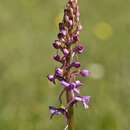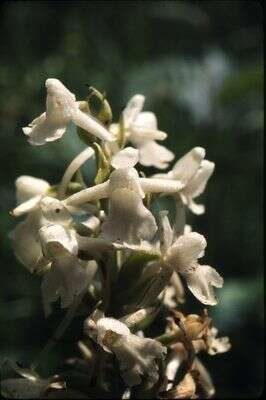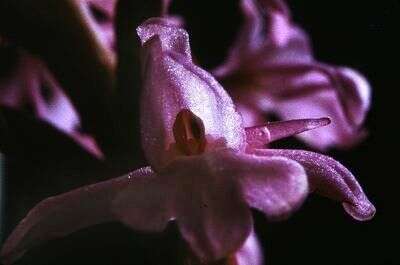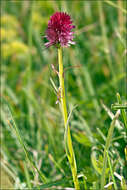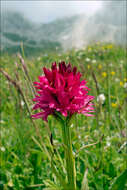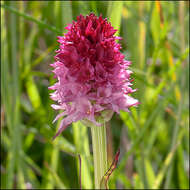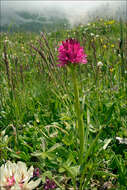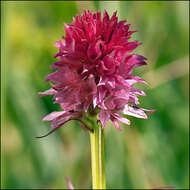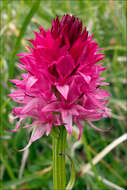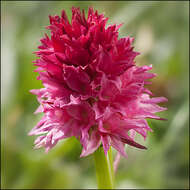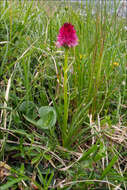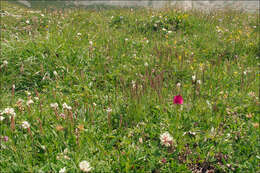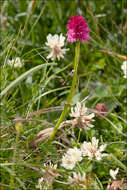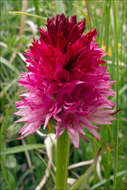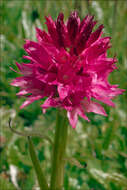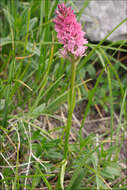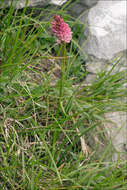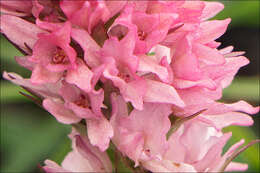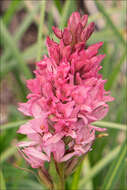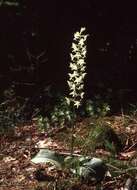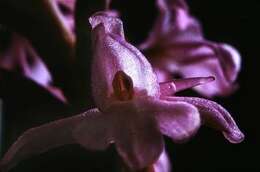-
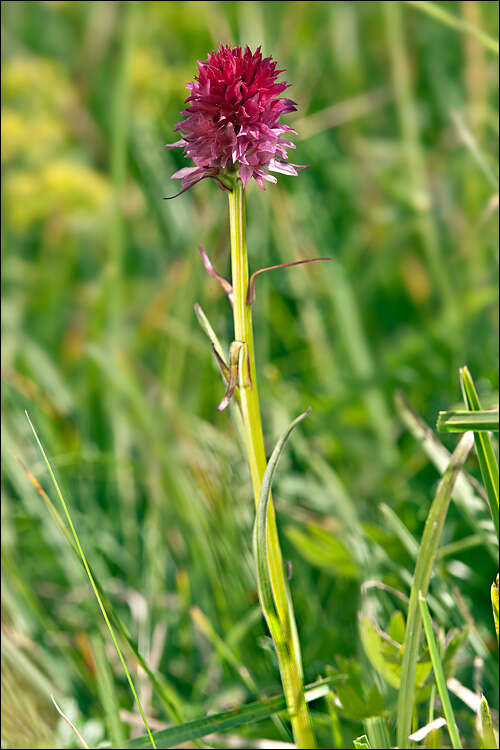
Nigritella bicolor, W. Foelsche Zweifarbiges KohlrschenSlo.: dvobarvna murka (? the name is not yet officially defined) Dat.: Jul. 08. 2012Lat.: (46.4000) Long.: (13.6000)Code: Bot_637/2012_DSC4375 Habitat: High mountain pasture, moderately inclined, slightly south west oriented, slope, calcareous ground, full sun, exposed to direct rain, average precipitations ~ 3.000 mm/year, average temperature 1-3 deg C, elevation 2.000 m (6.550 feet), alpine phytogeographical region.Substratum: soil.Place: Mt. Mangart region, East Julian Alps, Posoje, Slovenia EC Comment: The species is new to Slovenia. It was recognized as a new species in 2010 by W. Foelsche (see ref.:1.). Growing in a small group of six plants only. No more have been found yet. Geographic coordinates given are only approximate. Protected according to 'Uredba o zavarovanih prosto iveih rastlinskih vrstah'Ur.l. RS, t. 46/2004 (in the group of all Orchidaceae). Also enclosed in the Slovene Red List of rare and endangered species, marked by "V" representing a vulnerable species (as all Orchidaceae).Ref.:(1) W. Foelsche, Nigritella bicolor, ein neues apomiktisches Kohlrschen der Alpen, des Dinarischen Gebirges und der Karpaten. Journal Europischer Orchideen (2010), 42 (1), pp 31 82.(2) W. Foelsche,: Die Fundstellen von Nigritella bicolor. Anhang zu: Foelsche,W. (2010): Nigritella bicolor, ein neues apomiktisches Kohlrschen der Alpen, des Dinarischen Gebirges und der Karpaten. Journal Europischer Orchideen (2010), 42 (1, Supplement), pp 141.Micro 105mm/f2.8
-
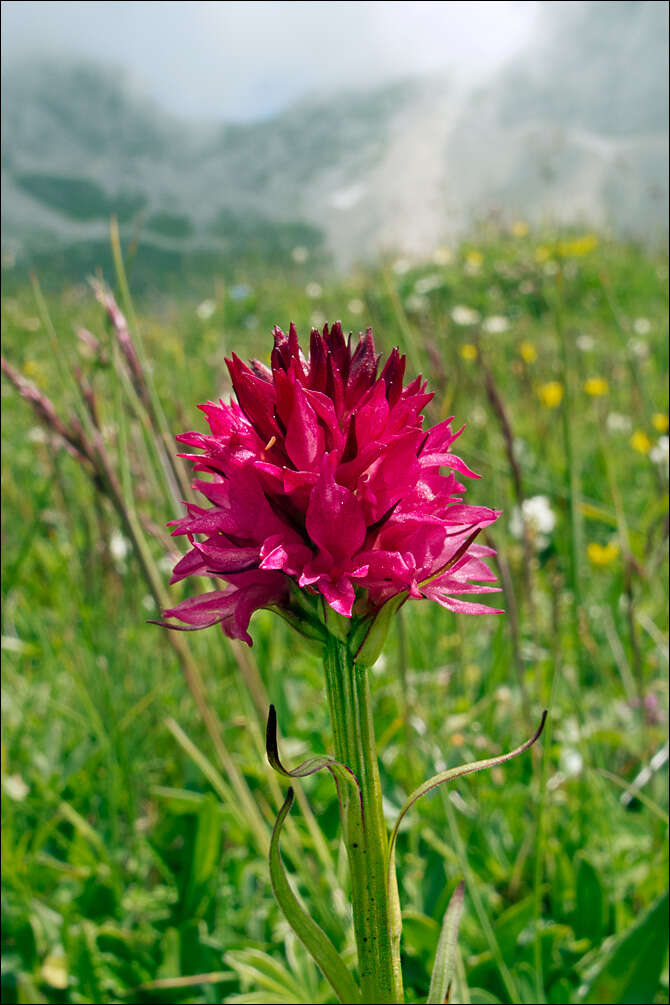
NOTE: Based on a message received from orchid specialist Mr. Wolfram Foelsche my initial determination of the species shown on the pictures of this observation (namely Nigritella widderi Teppner & E. Klein) is wrong. Nigritella widderi doesn't grow on Mangart's flats. According to him the pictures show Nigritella bicolor W. Foelsche. Some orchid experts consider the name Nigritella bicolor W. Foelsche synonymous with Nigritella miniata (Crantz) Janch..___________________________________________________Nigritella widderi Teppner & Klein, syn.: Nigritella rubra ssp. widderi (Teppner & Klein) Baumann & Lorenz, Gymnadenia widderi (Teppner & Klein) Teppner & KleinWidder's Nigritella, DE: Widders Mnnertreu, Widders KohlrschenSlo.: Widderjeva murkaDat.: July 1. 2015Lat.: 46.44176 Long.: 13.64343Code: Bot_897/2015_IMG8786Habitat: alpine grassland, open almost flat terrain, calcareous, skeletal ground, full sun, exposed to direct rain, average precipitations ~ 3.000 mm/year, average temperature 0 - 2 deg C, elevation 1.980 m (6.500 feet), alpine phytogeographical region. Substratum: soil.Place: Mt. Mangart region, Mangart's flats, west of the beginning of the terminal loop of Mt. Mangart tool road, East Julian Alps, Posoje, Slovenia EC Comment: Nigritella widderi was first described as a new taxon thirty years ago in 1985 in calcareous Northeast Alps in Austria. In Slovenia it was first found in Julian Alps south of Mt. Triglav, 2.863 m in 2011 (Ref.: ) . Up to now a few other stands have been found. To distinguish it from other red blooming Nigritella species is not always simple. The important typical traits are purple pink flowers at the bottom of the inflorescence, which are paler than the red ones on the top. The inflorescence looks like having two colors. Also dark purple red bracts, which can be seen among the flowers, are significant. The inflorescence is rather short and never distinctly cylindrical. There are also tiny morphological differences in rostellum, but it is almost impossible to observe them in the field and without a good hand lens or a microscope. In addition, one has to pick the flowers to make observations, which is prohibited, because the species is protected.In 2007 and 2012 I found several of these nice plants at the same place of Mangart's flats as in this case. At that time I determined them as Nigritella rubra. Namely, the taxonomy of genus Nigritella in Slovenia was very simple some time ago. We knew only three species: Nigritella rubra (plants with red flowers), Nigritella nigra (plants with dark red to almost black flowers) and endemic Nigritella rhellicani (with more or less pink flowers), which grows only in Kamnik Alps. Later Dr. W. Foelsche (Ref.:7) recognized my find on Mangart's flats published on the net as an example of a newly defined (in 2010) species Nigritella bicolor. However, the taxon has not been fully recognized and today most authors consider Nigritella bicolor Foelsche as a synonym of Nigritella miniata (Crantz) Janch. (Ref.: 3, Ref.: 8). Anyway, the latest Slovenian literature (Ref.3) lists six species and subspecies of genus Nigritella for my country. Five are of some shade of red. Distinguishing between them with certainty is difficult and, frankly, a too hard a nut for me.Only a single plant in bloom has been found at this place in 2015.Protected according to: Uredba o zavarovanih prostoiveih rastlinskih vrstah, poglavje A, Uradni list RS, t. 46/2004 (Regulation of protected wild plants, chapter A, Official Gazette of Republic Slovenia, no. 46/2004), (2004).Ref.:(1) H.Baumann, S. Kuenkele, R.Lorenz, Orchideen Europas, Ulmer (2006), p 138.(2) H.Kretzschmar, Die Orchideen Deutschlands und angrenzenden Lander, Quelle Meyer (2008), p 188.(3) B.Dolinar, Kukavievke v Sloveniji (Orchidaceae of Slovenia) (in Slovenian), Pipinova Knjiga (2015), p 125.(4) D. Aeschimann, K. Lauber, D.M. Moser, J.P. Theurillat, Flora Alpina, Vol. 2., Haupt (2004), p 1116.(5) M.A. Fischer, W. Adler, K. Oswald, Exkursionsflora fr sterreich, Liechtenstein und Sdtirol, LO Landesmuseen, Linz, Austria (2005), p 1044.(6) I. Dakskobler, B. Dolinar, B. Zupan, R. Iskra, P. Strgar, A. Trnkoczy, Nigritella widderi Tepner and E.Klein, a new species in the flora of Slovenia, Folia biologica et geologica, Academia Scientiarum et Artum Slovenica, 53/1-2 (2012), p 25. (7) W. Foelsche, Nigritella bicolor, ein neues apomiktisches Kohlrschen der Alpen, des Dinarischen Gebirges und der Karpaten. Journal Europischer Orchideen (2010), 42 (1), pp 31 82.(8) G. Perazza, R. Lorenz, Le orchidee dell'Italia nordorientale, atlante corologico e guida al riconoscimento, CIV pubblicazione del Museo Civico di Rovereto, Edizioni Osiride, Rovereto (2013).
-
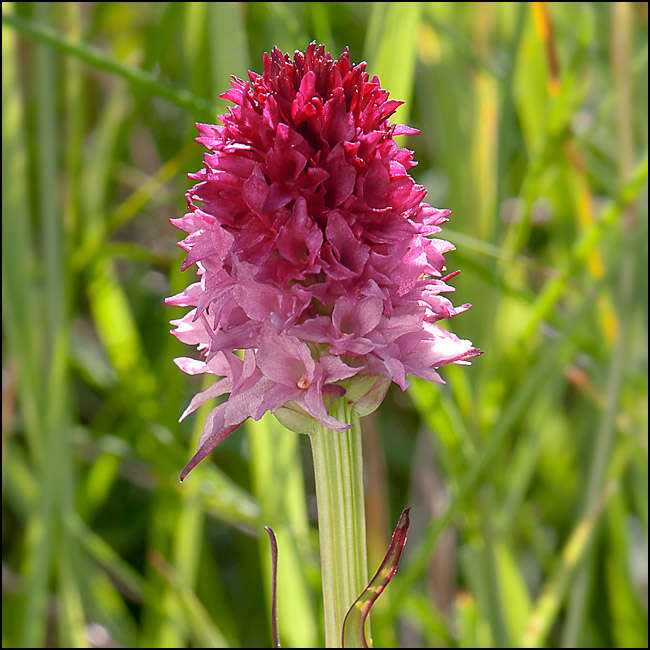
Nigritella bicolor, W. Foelsche Zweifarbiges KohlrschenSlo.: dvobarvna murka (? the name is not yet officially defined) Dat.: Jul. 08. 2012Lat.: (46.4000) Long.: (13.6000)Code: Bot_637/2012_DSC4375 Habitat: High mountain pasture, moderately inclined, slightly south west oriented, slope, calcareous ground, full sun, exposed to direct rain, average precipitations ~ 3.000 mm/year, average temperature 1-3 deg C, elevation 2.000 m (6.550 feet), alpine phytogeographical region.Substratum: soil.Place: Mt. Mangart region, East Julian Alps, Posoje, Slovenia EC Comment: The species is new to Slovenia. It was recognized as a new species in 2010 by W. Foelsche (see ref.:1.). Growing in a small group of six plants only. No more have been found yet. Geographic coordinates given are only approximate. Protected according to 'Uredba o zavarovanih prosto iveih rastlinskih vrstah'Ur.l. RS, t. 46/2004 (in the group of all Orchidaceae). Also enclosed in the Slovene Red List of rare and endangered species, marked by "V" representing a vulnerable species (as all Orchidaceae).Ref.:(1) W. Foelsche, Nigritella bicolor, ein neues apomiktisches Kohlrschen der Alpen, des Dinarischen Gebirges und der Karpaten. Journal Europischer Orchideen (2010), 42 (1), pp 31 82.(2) W. Foelsche,: Die Fundstellen von Nigritella bicolor. Anhang zu: Foelsche,W. (2010): Nigritella bicolor, ein neues apomiktisches Kohlrschen der Alpen, des Dinarischen Gebirges und der Karpaten. Journal Europischer Orchideen (2010), 42 (1, Supplement), pp 141.Micro 105mm/f2.8
-
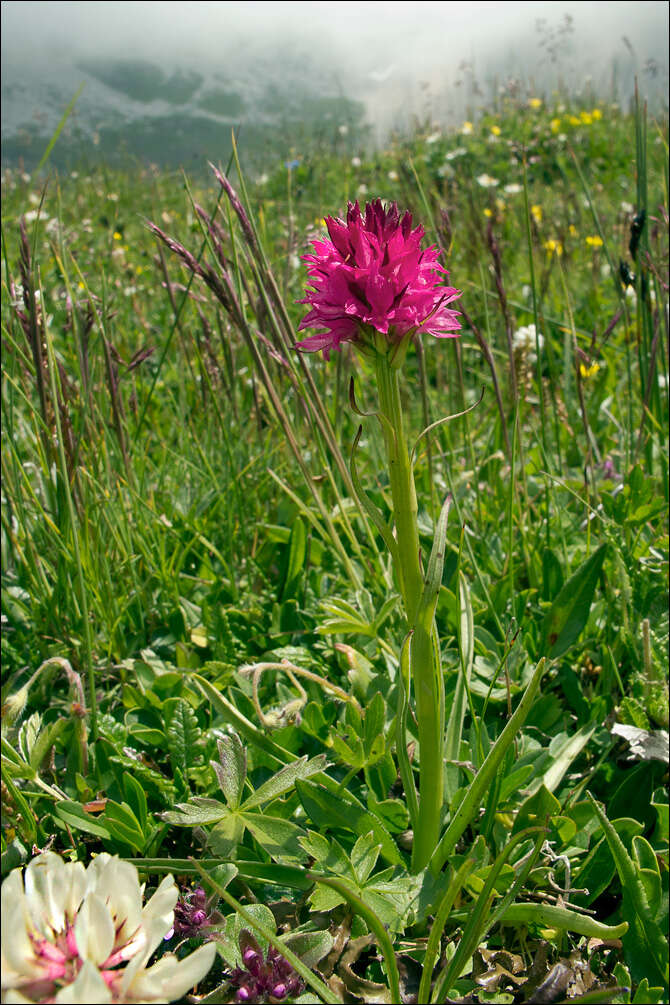
NOTE: Based on a message received from orchid specialist Mr. Wolfram Foelsche my initial determination of the species shown on the pictures of this observation (namely Nigritella widderi Teppner & E. Klein) is wrong. Nigritella widderi doesn't grow on Mangart's flats. According to him the pictures show Nigritella bicolor W. Foelsche. Some orchid experts consider the name Nigritella bicolor W. Foelsche synonymous with Nigritella miniata (Crantz) Janch..___________________________________________________Nigritella widderi Teppner & Klein, syn.: Nigritella rubra ssp. widderi (Teppner & Klein) Baumann & Lorenz, Gymnadenia widderi (Teppner & Klein) Teppner & KleinWidder's Nigritella, DE: Widders Mnnertreu, Widders KohlrschenSlo.: Widderjeva murkaDat.: July 1. 2015Lat.: 46.44176 Long.: 13.64343Code: Bot_897/2015_IMG8786Habitat: alpine grassland, open almost flat terrain, calcareous, skeletal ground, full sun, exposed to direct rain, average precipitations ~ 3.000 mm/year, average temperature 0 - 2 deg C, elevation 1.980 m (6.500 feet), alpine phytogeographical region. Substratum: soil.Place: Mt. Mangart region, Mangart's flats, west of the beginning of the terminal loop of Mt. Mangart tool road, East Julian Alps, Posoje, Slovenia EC Comment: Nigritella widderi was first described as a new taxon thirty years ago in 1985 in calcareous Northeast Alps in Austria. In Slovenia it was first found in Julian Alps south of Mt. Triglav, 2.863 m in 2011 (Ref.: ) . Up to now a few other stands have been found. To distinguish it from other red blooming Nigritella species is not always simple. The important typical traits are purple pink flowers at the bottom of the inflorescence, which are paler than the red ones on the top. The inflorescence looks like having two colors. Also dark purple red bracts, which can be seen among the flowers, are significant. The inflorescence is rather short and never distinctly cylindrical. There are also tiny morphological differences in rostellum, but it is almost impossible to observe them in the field and without a good hand lens or a microscope. In addition, one has to pick the flowers to make observations, which is prohibited, because the species is protected.In 2007 and 2012 I found several of these nice plants at the same place of Mangart's flats as in this case. At that time I determined them as Nigritella rubra. Namely, the taxonomy of genus Nigritella in Slovenia was very simple some time ago. We knew only three species: Nigritella rubra (plants with red flowers), Nigritella nigra (plants with dark red to almost black flowers) and endemic Nigritella rhellicani (with more or less pink flowers), which grows only in Kamnik Alps. Later Dr. W. Foelsche (Ref.:7) recognized my find on Mangart's flats published on the net as an example of a newly defined (in 2010) species Nigritella bicolor. However, the taxon has not been fully recognized and today most authors consider Nigritella bicolor Foelsche as a synonym of Nigritella miniata (Crantz) Janch. (Ref.: 3, Ref.: 8). Anyway, the latest Slovenian literature (Ref.3) lists six species and subspecies of genus Nigritella for my country. Five are of some shade of red. Distinguishing between them with certainty is difficult and, frankly, a too hard a nut for me.Only a single plant in bloom has been found at this place in 2015.Protected according to: Uredba o zavarovanih prostoiveih rastlinskih vrstah, poglavje A, Uradni list RS, t. 46/2004 (Regulation of protected wild plants, chapter A, Official Gazette of Republic Slovenia, no. 46/2004), (2004).Ref.:(1) H.Baumann, S. Kuenkele, R.Lorenz, Orchideen Europas, Ulmer (2006), p 138.(2) H.Kretzschmar, Die Orchideen Deutschlands und angrenzenden Lander, Quelle Meyer (2008), p 188.(3) B.Dolinar, Kukavievke v Sloveniji (Orchidaceae of Slovenia) (in Slovenian), Pipinova Knjiga (2015), p 125.(4) D. Aeschimann, K. Lauber, D.M. Moser, J.P. Theurillat, Flora Alpina, Vol. 2., Haupt (2004), p 1116.(5) M.A. Fischer, W. Adler, K. Oswald, Exkursionsflora fr sterreich, Liechtenstein und Sdtirol, LO Landesmuseen, Linz, Austria (2005), p 1044.(6) I. Dakskobler, B. Dolinar, B. Zupan, R. Iskra, P. Strgar, A. Trnkoczy, Nigritella widderi Tepner and E.Klein, a new species in the flora of Slovenia, Folia biologica et geologica, Academia Scientiarum et Artum Slovenica, 53/1-2 (2012), p 25. (7) W. Foelsche, Nigritella bicolor, ein neues apomiktisches Kohlrschen der Alpen, des Dinarischen Gebirges und der Karpaten. Journal Europischer Orchideen (2010), 42 (1), pp 31 82.(8) G. Perazza, R. Lorenz, Le orchidee dell'Italia nordorientale, atlante corologico e guida al riconoscimento, CIV pubblicazione del Museo Civico di Rovereto, Edizioni Osiride, Rovereto (2013).
-
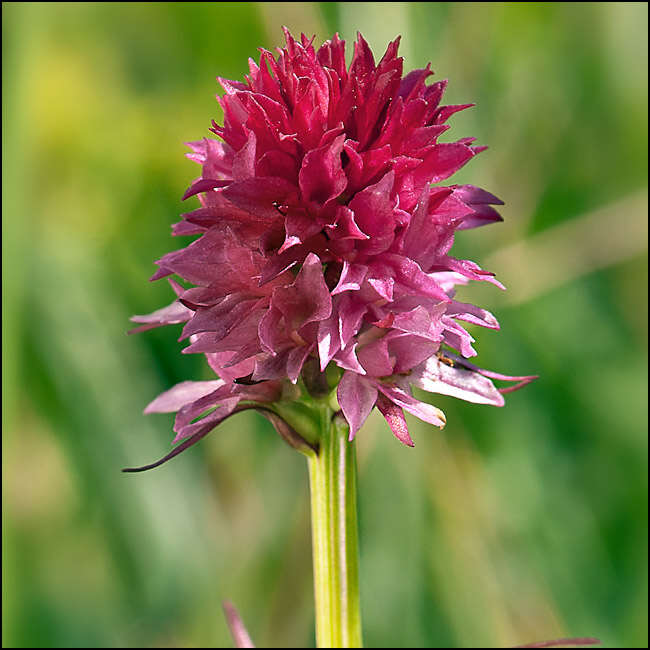
Nigritella bicolor, W. Foelsche Zweifarbiges KohlrschenSlo.: dvobarvna murka (? the name is not yet officially defined) Dat.: Jul. 08. 2012Lat.: (46.4000) Long.: (13.6000)Code: Bot_637/2012_DSC4375 Habitat: High mountain pasture, moderately inclined, slightly south west oriented, slope, calcareous ground, full sun, exposed to direct rain, average precipitations ~ 3.000 mm/year, average temperature 1-3 deg C, elevation 2.000 m (6.550 feet), alpine phytogeographical region.Substratum: soil.Place: Mt. Mangart region, East Julian Alps, Posoje, Slovenia EC Comment: The species is new to Slovenia. It was recognized as a new species in 2010 by W. Foelsche (see ref.:1.). Growing in a small group of six plants only. No more have been found yet. Geographic coordinates given are only approximate. Protected according to 'Uredba o zavarovanih prosto iveih rastlinskih vrstah'Ur.l. RS, t. 46/2004 (in the group of all Orchidaceae). Also enclosed in the Slovene Red List of rare and endangered species, marked by "V" representing a vulnerable species (as all Orchidaceae).Ref.:(1) W. Foelsche, Nigritella bicolor, ein neues apomiktisches Kohlrschen der Alpen, des Dinarischen Gebirges und der Karpaten. Journal Europischer Orchideen (2010), 42 (1), pp 31 82.(2) W. Foelsche,: Die Fundstellen von Nigritella bicolor. Anhang zu: Foelsche,W. (2010): Nigritella bicolor, ein neues apomiktisches Kohlrschen der Alpen, des Dinarischen Gebirges und der Karpaten. Journal Europischer Orchideen (2010), 42 (1, Supplement), pp 141.Micro 105mm/f2.8
-
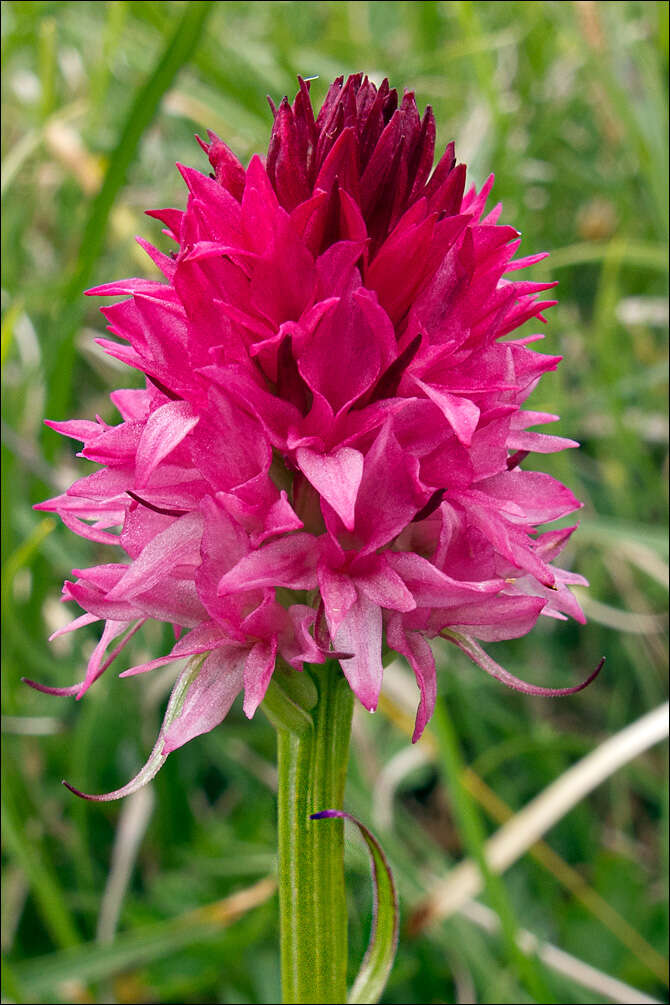
NOTE: Based on a message received from orchid specialist Mr. Wolfram Foelsche my initial determination of the species shown on the pictures of this observation (namely Nigritella widderi Teppner & E. Klein) is wrong. Nigritella widderi doesn't grow on Mangart's flats. According to him the pictures show Nigritella bicolor W. Foelsche. Some orchid experts consider the name Nigritella bicolor W. Foelsche synonymous with Nigritella miniata (Crantz) Janch..___________________________________________________Nigritella widderi Teppner & Klein, syn.: Nigritella rubra ssp. widderi (Teppner & Klein) Baumann & Lorenz, Gymnadenia widderi (Teppner & Klein) Teppner & KleinWidder's Nigritella, DE: Widders Mnnertreu, Widders KohlrschenSlo.: Widderjeva murkaDat.: July 1. 2015Lat.: 46.44280 Long.: 13.63677Code: Bot_897/2015_IMG8899Habitat: steep grassland, southeast oriented slope, on colluvial, skeletal, calcareous ground, open place, full sun, exposed to direct rain, average precipitations ~ 3.000 mm/year, average temperature about 0 deg C, elevation 2.075 m (6.800 feet), alpine phytogeographical region. Substratum: soil.Place: Mt. Mangart region, grass covered slopes of the ridge between ez jezik pass, 2.055 m and Sedelce pass, 2.031 m, East Julian Alps, Posoje, Slovenia EC.Comments: Nigritella widderi was first described as a new taxon thirty years ago in 1985 in calcareous Northeast Alps in Austria. In Slovenia it was first found in Julian Alps south of Mt. Triglav, 2.863 m in 2011 (Ref.: ) . Up to now a few other stands have been found. To distinguish it from other red blooming Nigritella species is not always simple. The important typical traits are purple pink flowers at the bottom of the inflorescence, which are paler than the red ones on the top. The inflorescence looks like having two colors. Also dark purple red bracts, which can be seen among the flowers, are significant. The inflorescence is rather short and never distinctly cylindrical. There are also tiny morphological differences in rostellum, but it is almost impossible to observe them in the field and without a good hand lens or a microscope. In addition, one has to pick the flowers to make observations, which is prohibited, because the species is protected.In 2007 and 2012 I found several of these nice plants at the same place of Mangart's flats as in this case. At that time I determined them as Nigritella rubra. Namely, the taxonomy of genus Nigritella in Slovenia was very simple some time ago. We knew only three species: Nigritella rubra (plants with red flowers), Nigritella nigra (plants with dark red to almost black flowers) and endemic Nigritella rhellicani (with more or less pink flowers), which grows only in Kamnik Alps. Later Dr. W. Foelsche (Ref.:7) recognized my find on Mangart's flats published on the net as an example of a newly defined (in 2010) species Nigritella bicolor. However, the taxon has not been fully recognized and today most authors consider Nigritella bicolor Foelsche as a synonym of Nigritella miniata (Crantz) Janch. (Ref.: 3, Ref.: 8). Anyway, the latest Slovenian literature (Ref.3) lists six species and subspecies of genus Nigritella for my country. Five are of some shade of red. Distinguishing between them with certainty is difficult and, frankly, a too hard a nut for me.Two plants in bloom has been found at this place in 2015.Protected according to: Uredba o zavarovanih prostoiveih rastlinskih vrstah, poglavje A, Uradni list RS, t. 46/2004 (Regulation of protected wild plants, chapter A, Official Gazette of Republic Slovenia, no. 46/2004), (2004).Ref.:(1) H.Baumann, S. Kuenkele, R.Lorenz, Orchideen Europas, Ulmer (2006), p 138.(2) H.Kretzschmar, Die Orchideen Deutschlands und angrenzenden Lander, Quelle Meyer (2008), p 188.(3) B.Dolinar, Kukavievke v Sloveniji (Orchidaceae of Slovenia) (in Slovenian), Pipinova Knjiga (2015), p 125.(4) D. Aeschimann, K. Lauber, D.M. Moser, J.P. Theurillat, Flora Alpina, Vol. 2., Haupt (2004), p 1116.(5) M.A. Fischer, W. Adler, K. Oswald, Exkursionsflora fr sterreich, Liechtenstein und Sdtirol, LO Landesmuseen, Linz, Austria (2005), p 1044.(6) I. Dakskobler, B. Dolinar, B. Zupan, R. Iskra, P. Strgar, A. Trnkoczy, Nigritella widderi Tepner and E.Klein, a new species in the flora of Slovenia, Folia biologica et geologica, Academia Scientiarum et Artum Slovenica, 53/1-2 (2012), p 25. (7) W. Foelsche, Nigritella bicolor, ein neues apomiktisches Kohlrschen der Alpen, des Dinarischen Gebirges und der Karpaten. Journal Europischer Orchideen (2010), 42 (1), pp 31 82.(8) G. Perazza, R. Lorenz, Le orchidee dell'Italia nordorientale, atlante corologico e guida al riconoscimento, CIV pubblicazione del Museo Civico di Rovereto, Edizioni Osiride, Rovereto (2013).
-

Nigritella bicolor, W. Foelsche Zweifarbiges KohlrschenSlo.: dvobarvna murka (? the name is not yet officially defined) Dat.: Jul. 08. 2012Lat.: (46.4000) Long.: (13.6000)Code: Bot_637/2012_DSC4375 Habitat: High mountain pasture, moderately inclined, slightly south west oriented, slope, calcareous ground, full sun, exposed to direct rain, average precipitations ~ 3.000 mm/year, average temperature 1-3 deg C, elevation 2.000 m (6.550 feet), alpine phytogeographical region.Substratum: soil.Place: Mt. Mangart region, East Julian Alps, Posoje, Slovenia EC Comment: The species is new to Slovenia. It was recognized as a new species in 2010 by W. Foelsche (see ref.:1.). Growing in a small group of six plants only. No more have been found yet. Geographic coordinates given are only approximate. Protected according to 'Uredba o zavarovanih prosto iveih rastlinskih vrstah'Ur.l. RS, t. 46/2004 (in the group of all Orchidaceae). Also enclosed in the Slovene Red List of rare and endangered species, marked by "V" representing a vulnerable species (as all Orchidaceae).Ref.:(1) W. Foelsche, Nigritella bicolor, ein neues apomiktisches Kohlrschen der Alpen, des Dinarischen Gebirges und der Karpaten. Journal Europischer Orchideen (2010), 42 (1), pp 31 82.(2) W. Foelsche,: Die Fundstellen von Nigritella bicolor. Anhang zu: Foelsche,W. (2010): Nigritella bicolor, ein neues apomiktisches Kohlrschen der Alpen, des Dinarischen Gebirges und der Karpaten. Journal Europischer Orchideen (2010), 42 (1, Supplement), pp 141.Micro 105mm/f2.8
-
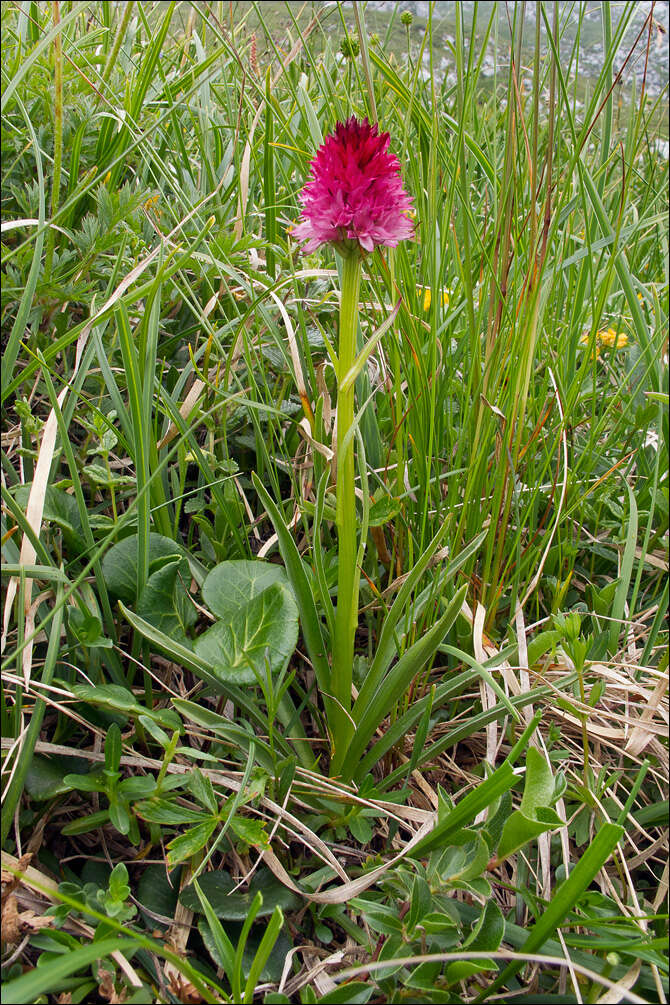
NOTE: Based on a message received from orchid specialist Mr. Wolfram Foelsche my initial determination of the species shown on the pictures of this observation (namely Nigritella widderi Teppner & E. Klein) is wrong. Nigritella widderi doesn't grow on Mangart's flats. According to him the pictures show Nigritella bicolor W. Foelsche. Some orchid experts consider the name Nigritella bicolor W. Foelsche synonymous with Nigritella miniata (Crantz) Janch..___________________________________________________Nigritella widderi Teppner & Klein, syn.: Nigritella rubra ssp. widderi (Teppner & Klein) Baumann & Lorenz, Gymnadenia widderi (Teppner & Klein) Teppner & KleinWidder's Nigritella, DE: Widders Mnnertreu, Widders KohlrschenSlo.: Widderjeva murkaDat.: July 1. 2015Lat.: 46.44253 Long.: 46.44253Code: Bot_897/2015_IMG8941Picture file names: from Nigritella-widderi_raw_20 to Nigritella-widderi_raw_22. Habitat: Moderately steep grassland, east oriented mountain slope, on colluvial, skeletal, calcareous ground, open place, full sun, exposed to direct rain, average precipitations ~ 3.000 mm/year, average temperature about 0 deg C, elevation 2.040 m (6.700 feet), alpine phytogeographical region.Substratum: soil.Place: Mt. Mangart region, slopes on the right side of the main ravine on Mangart's flats, west of the ez jezik pass, 2.055 m, East Julian Alps, Posoje, Slovenia EC Comments: Nigritella widderi was first described as a new taxon thirty years ago in 1985 in calcareous Northeast Alps in Austria. In Slovenia it was first found in Julian Alps south of Mt. Triglav, 2.863 m in 2011 (Ref.: ) . Up to now a few other stands have been found. To distinguish it from other red blooming Nigritella species is not always simple. The important typical traits are purple pink flowers at the bottom of the inflorescence, which are paler than the red ones on the top. The inflorescence looks like having two colors. Also dark purple red bracts, which can be seen among the flowers, are significant. The inflorescence is rather short and never distinctly cylindrical. There are also tiny morphological differences in rostellum, but it is almost impossible to observe them in the field and without a good hand lens or a microscope. In addition, one has to pick the flowers to make observations, which is prohibited, because the species is protected.In 2007 and 2012 I found several of these nice plants at the same place of Mangart's flats as in this case. At that time I determined them as Nigritella rubra. Namely, the taxonomy of genus Nigritella in Slovenia was very simple some time ago. We knew only three species: Nigritella rubra (plants with red flowers), Nigritella nigra (plants with dark red to almost black flowers) and endemic Nigritella rhellicani (with more or less pink flowers), which grows only in Kamnik Alps. Later Dr. W. Foelsche (Ref.:7) recognized my find on Mangart's flats published on the net as an example of a newly defined (in 2010) species Nigritella bicolor. However, the taxon has not been fully recognized and today most authors consider Nigritella bicolor Foelsche as a synonym of Nigritella miniata (Crantz) Janch. (Ref.: 3, Ref.: 8). Anyway, the latest Slovenian literature (Ref.3) lists six species and subspecies of genus Nigritella for my country. Five are of some shade of red. Distinguishing between them with certainty is difficult and, frankly, a too hard a nut for me.More than 15 plants have been observed at this place in 2015.Protected according to: Uredba o zavarovanih prostoiveih rastlinskih vrstah, poglavje A, Uradni list RS, t. 46/2004 (Regulation of protected wild plants, chapter A, Official Gazette of Republic Slovenia, no. 46/2004), (2004).Ref.:(1) H.Baumann, S. Kuenkele, R.Lorenz, Orchideen Europas, Ulmer (2006), p 138.(2) H.Kretzschmar, Die Orchideen Deutschlands und angrenzenden Lander, Quelle Meyer (2008), p 188.(3) B.Dolinar, Kukavievke v Sloveniji (Orchidaceae of Slovenia) (in Slovenian), Pipinova Knjiga (2015), p 125.(4) D. Aeschimann, K. Lauber, D.M. Moser, J.P. Theurillat, Flora Alpina, Vol. 2., Haupt (2004), p 1116.(5) M.A. Fischer, W. Adler, K. Oswald, Exkursionsflora fr sterreich, Liechtenstein und Sdtirol, LO Landesmuseen, Linz, Austria (2005), p 1044.(6) I. Dakskobler, B. Dolinar, B. Zupan, R. Iskra, P. Strgar, A. Trnkoczy, Nigritella widderi Tepner and E.Klein, a new species in the flora of Slovenia, Folia biologica et geologica, Academia Scientiarum et Artum Slovenica, 53/1-2 (2012), p 25.(7) W. Foelsche, Nigritella bicolor, ein neues apomiktisches Kohlrschen der Alpen, des Dinarischen Gebirges und der Karpaten. Journal Europischer Orchideen (2010), 42 (1), pp 31 82.(8) G. Perazza, R. Lorenz, Le orchidee dell'Italia nordorientale, atlante corologico e guida al riconoscimento, CIV pubblicazione del Museo Civico di Rovereto, Edizioni Osiride, Rovereto (2013).
-

NOTE: Based on a message received from orchid specialist Mr. Wolfram Foelsche my initial determination of the species shown on the pictures of this observation (namely Nigritella widderi Teppner & E. Klein) is wrong. Nigritella widderi doesn't grow on Mangart's flats. According to him the pictures show Nigritella bicolor W. Foelsche. Some orchid experts consider the name Nigritella bicolor W. Foelsche synonymous with Nigritella miniata (Crantz) Janch..___________________________________________________Nigritella widderi Teppner & Klein, syn.: Nigritella rubra ssp. widderi (Teppner & Klein) Baumann & Lorenz, Gymnadenia widderi (Teppner & Klein) Teppner & KleinWidder's Nigritella, DE: Widders Mnnertreu, Widders KohlrschenSlo.: Widderjeva murkaDat.: July 1. 2015Lat.: 46.44176 Long.: 13.64343Code: Bot_897/2015_IMG8786Habitat: alpine grassland, open almost flat terrain, calcareous, skeletal ground, full sun, exposed to direct rain, average precipitations ~ 3.000 mm/year, average temperature 0 - 2 deg C, elevation 1.980 m (6.500 feet), alpine phytogeographical region. Substratum: soil.Place: Mt. Mangart region, Mangart's flats, west of the beginning of the terminal loop of Mt. Mangart tool road, East Julian Alps, Posoje, Slovenia EC Comment: Nigritella widderi was first described as a new taxon thirty years ago in 1985 in calcareous Northeast Alps in Austria. In Slovenia it was first found in Julian Alps south of Mt. Triglav, 2.863 m in 2011 (Ref.: ) . Up to now a few other stands have been found. To distinguish it from other red blooming Nigritella species is not always simple. The important typical traits are purple pink flowers at the bottom of the inflorescence, which are paler than the red ones on the top. The inflorescence looks like having two colors. Also dark purple red bracts, which can be seen among the flowers, are significant. The inflorescence is rather short and never distinctly cylindrical. There are also tiny morphological differences in rostellum, but it is almost impossible to observe them in the field and without a good hand lens or a microscope. In addition, one has to pick the flowers to make observations, which is prohibited, because the species is protected.In 2007 and 2012 I found several of these nice plants at the same place of Mangart's flats as in this case. At that time I determined them as Nigritella rubra. Namely, the taxonomy of genus Nigritella in Slovenia was very simple some time ago. We knew only three species: Nigritella rubra (plants with red flowers), Nigritella nigra (plants with dark red to almost black flowers) and endemic Nigritella rhellicani (with more or less pink flowers), which grows only in Kamnik Alps. Later Dr. W. Foelsche (Ref.:7) recognized my find on Mangart's flats published on the net as an example of a newly defined (in 2010) species Nigritella bicolor. However, the taxon has not been fully recognized and today most authors consider Nigritella bicolor Foelsche as a synonym of Nigritella miniata (Crantz) Janch. (Ref.: 3, Ref.: 8). Anyway, the latest Slovenian literature (Ref.3) lists six species and subspecies of genus Nigritella for my country. Five are of some shade of red. Distinguishing between them with certainty is difficult and, frankly, a too hard a nut for me.Only a single plant in bloom has been found at this place in 2015.Protected according to: Uredba o zavarovanih prostoiveih rastlinskih vrstah, poglavje A, Uradni list RS, t. 46/2004 (Regulation of protected wild plants, chapter A, Official Gazette of Republic Slovenia, no. 46/2004), (2004).Ref.:(1) H.Baumann, S. Kuenkele, R.Lorenz, Orchideen Europas, Ulmer (2006), p 138.(2) H.Kretzschmar, Die Orchideen Deutschlands und angrenzenden Lander, Quelle Meyer (2008), p 188.(3) B.Dolinar, Kukavievke v Sloveniji (Orchidaceae of Slovenia) (in Slovenian), Pipinova Knjiga (2015), p 125.(4) D. Aeschimann, K. Lauber, D.M. Moser, J.P. Theurillat, Flora Alpina, Vol. 2., Haupt (2004), p 1116.(5) M.A. Fischer, W. Adler, K. Oswald, Exkursionsflora fr sterreich, Liechtenstein und Sdtirol, LO Landesmuseen, Linz, Austria (2005), p 1044.(6) I. Dakskobler, B. Dolinar, B. Zupan, R. Iskra, P. Strgar, A. Trnkoczy, Nigritella widderi Tepner and E.Klein, a new species in the flora of Slovenia, Folia biologica et geologica, Academia Scientiarum et Artum Slovenica, 53/1-2 (2012), p 25. (7) W. Foelsche, Nigritella bicolor, ein neues apomiktisches Kohlrschen der Alpen, des Dinarischen Gebirges und der Karpaten. Journal Europischer Orchideen (2010), 42 (1), pp 31 82.(8) G. Perazza, R. Lorenz, Le orchidee dell'Italia nordorientale, atlante corologico e guida al riconoscimento, CIV pubblicazione del Museo Civico di Rovereto, Edizioni Osiride, Rovereto (2013).
-
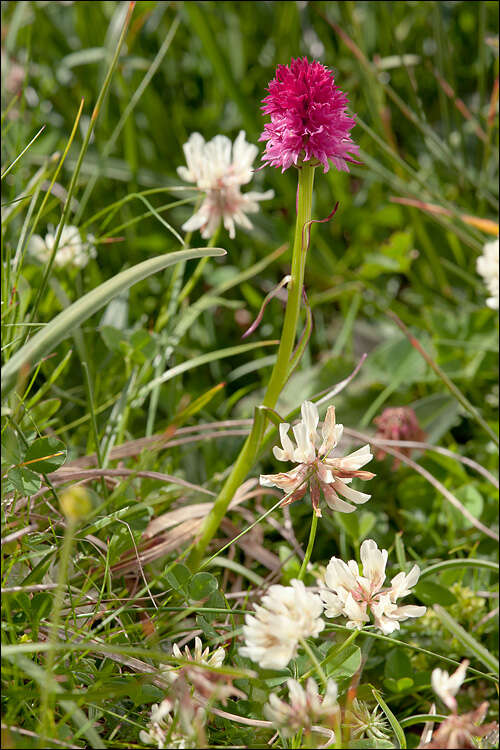
Nigritella bicolor, W. Foelsche Zweifarbiges KohlrschenSlo.: dvobarvna murka (? the name is not yet officially defined) Dat.: Jul. 08. 2012Lat.: (46.4000) Long.: (13.6000)Code: Bot_637/2012_DSC4375 Habitat: High mountain pasture, moderately inclined, slightly south west oriented, slope, calcareous ground, full sun, exposed to direct rain, average precipitations ~ 3.000 mm/year, average temperature 1-3 deg C, elevation 2.000 m (6.550 feet), alpine phytogeographical region.Substratum: soil.Place: Mt. Mangart region, East Julian Alps, Posoje, Slovenia EC Comment: The species is new to Slovenia. It was recognized as a new species in 2010 by W. Foelsche (see ref.:1.). Growing in a small group of six plants only. No more have been found yet. Geographic coordinates given are only approximate. Protected according to 'Uredba o zavarovanih prosto iveih rastlinskih vrstah'Ur.l. RS, t. 46/2004 (in the group of all Orchidaceae). Also enclosed in the Slovene Red List of rare and endangered species, marked by "V" representing a vulnerable species (as all Orchidaceae).Ref.:(1) W. Foelsche, Nigritella bicolor, ein neues apomiktisches Kohlrschen der Alpen, des Dinarischen Gebirges und der Karpaten. Journal Europischer Orchideen (2010), 42 (1), pp 31 82.(2) W. Foelsche,: Die Fundstellen von Nigritella bicolor. Anhang zu: Foelsche,W. (2010): Nigritella bicolor, ein neues apomiktisches Kohlrschen der Alpen, des Dinarischen Gebirges und der Karpaten. Journal Europischer Orchideen (2010), 42 (1, Supplement), pp 141.Micro 105mm/f2.8
-

Nigritella bicolor, W. Foelsche Zweifarbiges KohlrschenSlo.: dvobarvna murka (? the name is not yet officially defined) Dat.: Jul. 08. 2012Lat.: (46.4000) Long.: (13.6000)Code: Bot_637/2012_DSC4375 Habitat: High mountain pasture, moderately inclined, slightly south west oriented, slope, calcareous ground, full sun, exposed to direct rain, average precipitations ~ 3.000 mm/year, average temperature 1-3 deg C, elevation 2.000 m (6.550 feet), alpine phytogeographical region.Substratum: soil.Place: Mt. Mangart region, East Julian Alps, Posoje, Slovenia EC Comment: The species is new to Slovenia. It was recognized as a new species in 2010 by W. Foelsche (see ref.:1.). Growing in a small group of six plants only. No more have been found yet. Geographic coordinates given are only approximate. Protected according to 'Uredba o zavarovanih prosto iveih rastlinskih vrstah'Ur.l. RS, t. 46/2004 (in the group of all Orchidaceae). Also enclosed in the Slovene Red List of rare and endangered species, marked by "V" representing a vulnerable species (as all Orchidaceae).Ref.:(1) W. Foelsche, Nigritella bicolor, ein neues apomiktisches Kohlrschen der Alpen, des Dinarischen Gebirges und der Karpaten. Journal Europischer Orchideen (2010), 42 (1), pp 31 82.(2) W. Foelsche,: Die Fundstellen von Nigritella bicolor. Anhang zu: Foelsche,W. (2010): Nigritella bicolor, ein neues apomiktisches Kohlrschen der Alpen, des Dinarischen Gebirges und der Karpaten. Journal Europischer Orchideen (2010), 42 (1, Supplement), pp 141.Micro 105mm/f2.8
-
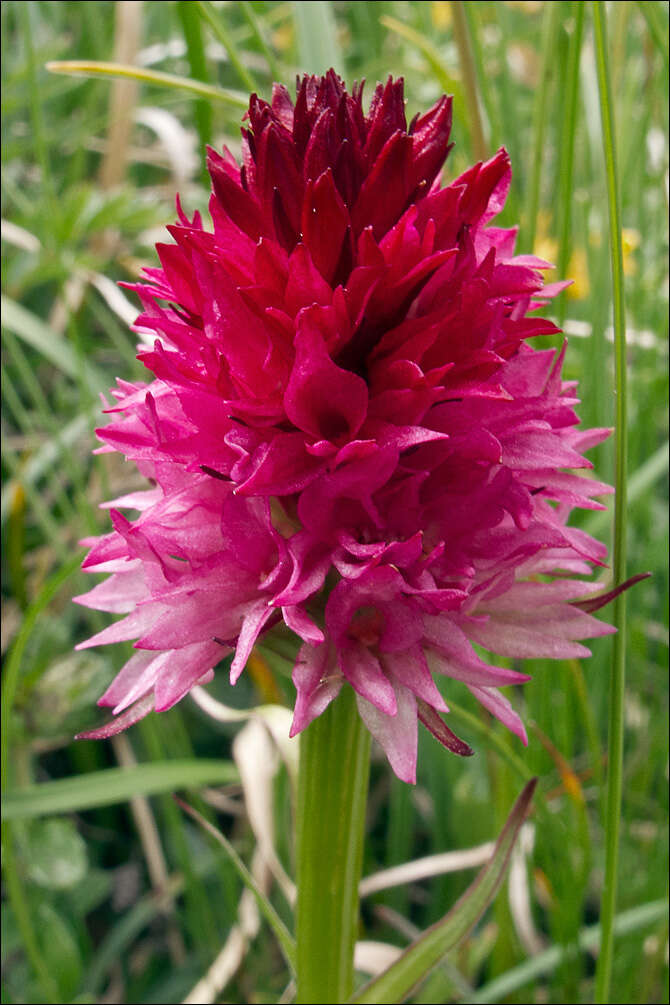
NOTE: Based on a message received from orchid specialist Mr. Wolfram Foelsche my initial determination of the species shown on the pictures of this observation (namely Nigritella widderi Teppner & E. Klein) is wrong. Nigritella widderi doesn't grow on Mangart's flats. According to him the pictures show Nigritella bicolor W. Foelsche. Some orchid experts consider the name Nigritella bicolor W. Foelsche synonymous with Nigritella miniata (Crantz) Janch..___________________________________________________Nigritella widderi Teppner & Klein, syn.: Nigritella rubra ssp. widderi (Teppner & Klein) Baumann & Lorenz, Gymnadenia widderi (Teppner & Klein) Teppner & KleinWidder's Nigritella, DE: Widders Mnnertreu, Widders KohlrschenSlo.: Widderjeva murkaDat.: July 1. 2015Lat.: 46.44253 Long.: 46.44253Code: Bot_897/2015_IMG8941Picture file names: from Nigritella-widderi_raw_20 to Nigritella-widderi_raw_22. Habitat: Moderately steep grassland, east oriented mountain slope, on colluvial, skeletal, calcareous ground, open place, full sun, exposed to direct rain, average precipitations ~ 3.000 mm/year, average temperature about 0 deg C, elevation 2.040 m (6.700 feet), alpine phytogeographical region.Substratum: soil.Place: Mt. Mangart region, slopes on the right side of the main ravine on Mangart's flats, west of the ez jezik pass, 2.055 m, East Julian Alps, Posoje, Slovenia EC Comments: Nigritella widderi was first described as a new taxon thirty years ago in 1985 in calcareous Northeast Alps in Austria. In Slovenia it was first found in Julian Alps south of Mt. Triglav, 2.863 m in 2011 (Ref.: ) . Up to now a few other stands have been found. To distinguish it from other red blooming Nigritella species is not always simple. The important typical traits are purple pink flowers at the bottom of the inflorescence, which are paler than the red ones on the top. The inflorescence looks like having two colors. Also dark purple red bracts, which can be seen among the flowers, are significant. The inflorescence is rather short and never distinctly cylindrical. There are also tiny morphological differences in rostellum, but it is almost impossible to observe them in the field and without a good hand lens or a microscope. In addition, one has to pick the flowers to make observations, which is prohibited, because the species is protected.In 2007 and 2012 I found several of these nice plants at the same place of Mangart's flats as in this case. At that time I determined them as Nigritella rubra. Namely, the taxonomy of genus Nigritella in Slovenia was very simple some time ago. We knew only three species: Nigritella rubra (plants with red flowers), Nigritella nigra (plants with dark red to almost black flowers) and endemic Nigritella rhellicani (with more or less pink flowers), which grows only in Kamnik Alps. Later Dr. W. Foelsche (Ref.:7) recognized my find on Mangart's flats published on the net as an example of a newly defined (in 2010) species Nigritella bicolor. However, the taxon has not been fully recognized and today most authors consider Nigritella bicolor Foelsche as a synonym of Nigritella miniata (Crantz) Janch. (Ref.: 3, Ref.: 8). Anyway, the latest Slovenian literature (Ref.3) lists six species and subspecies of genus Nigritella for my country. Five are of some shade of red. Distinguishing between them with certainty is difficult and, frankly, a too hard a nut for me.More than 15 plants have been observed at this place in 2015.Protected according to: Uredba o zavarovanih prostoiveih rastlinskih vrstah, poglavje A, Uradni list RS, t. 46/2004 (Regulation of protected wild plants, chapter A, Official Gazette of Republic Slovenia, no. 46/2004), (2004).Ref.:(1) H.Baumann, S. Kuenkele, R.Lorenz, Orchideen Europas, Ulmer (2006), p 138.(2) H.Kretzschmar, Die Orchideen Deutschlands und angrenzenden Lander, Quelle Meyer (2008), p 188.(3) B.Dolinar, Kukavievke v Sloveniji (Orchidaceae of Slovenia) (in Slovenian), Pipinova Knjiga (2015), p 125.(4) D. Aeschimann, K. Lauber, D.M. Moser, J.P. Theurillat, Flora Alpina, Vol. 2., Haupt (2004), p 1116.(5) M.A. Fischer, W. Adler, K. Oswald, Exkursionsflora fr sterreich, Liechtenstein und Sdtirol, LO Landesmuseen, Linz, Austria (2005), p 1044.(6) I. Dakskobler, B. Dolinar, B. Zupan, R. Iskra, P. Strgar, A. Trnkoczy, Nigritella widderi Tepner and E.Klein, a new species in the flora of Slovenia, Folia biologica et geologica, Academia Scientiarum et Artum Slovenica, 53/1-2 (2012), p 25.(7) W. Foelsche, Nigritella bicolor, ein neues apomiktisches Kohlrschen der Alpen, des Dinarischen Gebirges und der Karpaten. Journal Europischer Orchideen (2010), 42 (1), pp 31 82.(8) G. Perazza, R. Lorenz, Le orchidee dell'Italia nordorientale, atlante corologico e guida al riconoscimento, CIV pubblicazione del Museo Civico di Rovereto, Edizioni Osiride, Rovereto (2013).
-
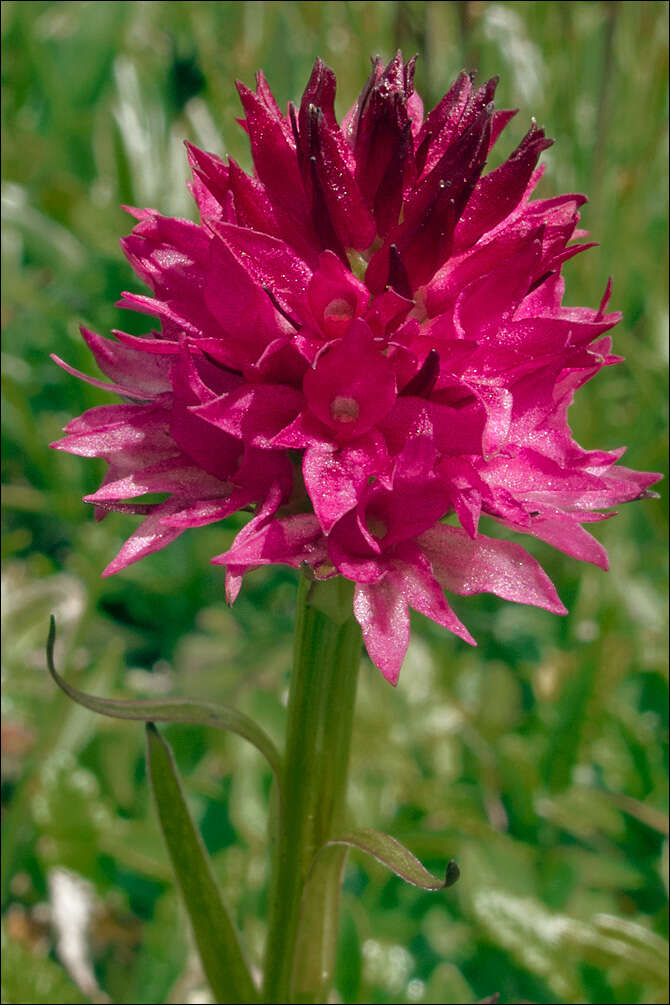
NOTE: Based on a message received from orchid specialist Mr. Wolfram Foelsche my initial determination of the species shown on the pictures of this observation (namely Nigritella widderi Teppner & E. Klein) is wrong. Nigritella widderi doesn't grow on Mangart's flats. According to him the pictures show Nigritella bicolor W. Foelsche. Some orchid experts consider the name Nigritella bicolor W. Foelsche synonymous with Nigritella miniata (Crantz) Janch..___________________________________________________Nigritella widderi Teppner & Klein, syn.: Nigritella rubra ssp. widderi (Teppner & Klein) Baumann & Lorenz, Gymnadenia widderi (Teppner & Klein) Teppner & KleinWidder's Nigritella, DE: Widders Mnnertreu, Widders KohlrschenSlo.: Widderjeva murkaDat.: July 1. 2015Lat.: 46.44176 Long.: 13.64343Code: Bot_897/2015_IMG8786Habitat: alpine grassland, open almost flat terrain, calcareous, skeletal ground, full sun, exposed to direct rain, average precipitations ~ 3.000 mm/year, average temperature 0 - 2 deg C, elevation 1.980 m (6.500 feet), alpine phytogeographical region. Substratum: soil.Place: Mt. Mangart region, Mangart's flats, west of the beginning of the terminal loop of Mt. Mangart tool road, East Julian Alps, Posoje, Slovenia EC Comment: Nigritella widderi was first described as a new taxon thirty years ago in 1985 in calcareous Northeast Alps in Austria. In Slovenia it was first found in Julian Alps south of Mt. Triglav, 2.863 m in 2011 (Ref.: ) . Up to now a few other stands have been found. To distinguish it from other red blooming Nigritella species is not always simple. The important typical traits are purple pink flowers at the bottom of the inflorescence, which are paler than the red ones on the top. The inflorescence looks like having two colors. Also dark purple red bracts, which can be seen among the flowers, are significant. The inflorescence is rather short and never distinctly cylindrical. There are also tiny morphological differences in rostellum, but it is almost impossible to observe them in the field and without a good hand lens or a microscope. In addition, one has to pick the flowers to make observations, which is prohibited, because the species is protected.In 2007 and 2012 I found several of these nice plants at the same place of Mangart's flats as in this case. At that time I determined them as Nigritella rubra. Namely, the taxonomy of genus Nigritella in Slovenia was very simple some time ago. We knew only three species: Nigritella rubra (plants with red flowers), Nigritella nigra (plants with dark red to almost black flowers) and endemic Nigritella rhellicani (with more or less pink flowers), which grows only in Kamnik Alps. Later Dr. W. Foelsche (Ref.:7) recognized my find on Mangart's flats published on the net as an example of a newly defined (in 2010) species Nigritella bicolor. However, the taxon has not been fully recognized and today most authors consider Nigritella bicolor Foelsche as a synonym of Nigritella miniata (Crantz) Janch. (Ref.: 3, Ref.: 8). Anyway, the latest Slovenian literature (Ref.3) lists six species and subspecies of genus Nigritella for my country. Five are of some shade of red. Distinguishing between them with certainty is difficult and, frankly, a too hard a nut for me.Only a single plant in bloom has been found at this place in 2015.Protected according to: Uredba o zavarovanih prostoiveih rastlinskih vrstah, poglavje A, Uradni list RS, t. 46/2004 (Regulation of protected wild plants, chapter A, Official Gazette of Republic Slovenia, no. 46/2004), (2004).Ref.:(1) H.Baumann, S. Kuenkele, R.Lorenz, Orchideen Europas, Ulmer (2006), p 138.(2) H.Kretzschmar, Die Orchideen Deutschlands und angrenzenden Lander, Quelle Meyer (2008), p 188.(3) B.Dolinar, Kukavievke v Sloveniji (Orchidaceae of Slovenia) (in Slovenian), Pipinova Knjiga (2015), p 125.(4) D. Aeschimann, K. Lauber, D.M. Moser, J.P. Theurillat, Flora Alpina, Vol. 2., Haupt (2004), p 1116.(5) M.A. Fischer, W. Adler, K. Oswald, Exkursionsflora fr sterreich, Liechtenstein und Sdtirol, LO Landesmuseen, Linz, Austria (2005), p 1044.(6) I. Dakskobler, B. Dolinar, B. Zupan, R. Iskra, P. Strgar, A. Trnkoczy, Nigritella widderi Tepner and E.Klein, a new species in the flora of Slovenia, Folia biologica et geologica, Academia Scientiarum et Artum Slovenica, 53/1-2 (2012), p 25. (7) W. Foelsche, Nigritella bicolor, ein neues apomiktisches Kohlrschen der Alpen, des Dinarischen Gebirges und der Karpaten. Journal Europischer Orchideen (2010), 42 (1), pp 31 82.(8) G. Perazza, R. Lorenz, Le orchidee dell'Italia nordorientale, atlante corologico e guida al riconoscimento, CIV pubblicazione del Museo Civico di Rovereto, Edizioni Osiride, Rovereto (2013).
-

NOTE: Based on a message received from orchid specialist Mr. Wolfram Foelsche my initial determination of the species shown on the pictures of this observation (namely Nigritella widderi Teppner & E. Klein) is wrong. Nigritella widderi doesn't grow on Mangart's flats. According to him the pictures show Nigritella bicolor W. Foelsche. Some orchid experts consider the name Nigritella bicolor W. Foelsche synonymous with Nigritella miniata (Crantz) Janch..___________________________________________________Nigritella widderi Teppner & Klein, syn.: Nigritella rubra ssp. widderi (Teppner & Klein) Baumann & Lorenz, Gymnadenia widderi (Teppner & Klein) Teppner & KleinWidder's Nigritella, DE: Widders Mnnertreu, Widders KohlrschenSlo.: Widderjeva murkaDat.: July 1. 2015Lat.: 46.44253 Long.: 46.44253Code: Bot_897/2015_IMG8941Picture file names: from Nigritella-widderi_raw_20 to Nigritella-widderi_raw_22. Habitat: Moderately steep grassland, east oriented mountain slope, on colluvial, skeletal, calcareous ground, open place, full sun, exposed to direct rain, average precipitations ~ 3.000 mm/year, average temperature about 0 deg C, elevation 2.040 m (6.700 feet), alpine phytogeographical region.Substratum: soil.Place: Mt. Mangart region, slopes on the right side of the main ravine on Mangart's flats, west of the ez jezik pass, 2.055 m, East Julian Alps, Posoje, Slovenia EC Comments: Nigritella widderi was first described as a new taxon thirty years ago in 1985 in calcareous Northeast Alps in Austria. In Slovenia it was first found in Julian Alps south of Mt. Triglav, 2.863 m in 2011 (Ref.: ) . Up to now a few other stands have been found. To distinguish it from other red blooming Nigritella species is not always simple. The important typical traits are purple pink flowers at the bottom of the inflorescence, which are paler than the red ones on the top. The inflorescence looks like having two colors. Also dark purple red bracts, which can be seen among the flowers, are significant. The inflorescence is rather short and never distinctly cylindrical. There are also tiny morphological differences in rostellum, but it is almost impossible to observe them in the field and without a good hand lens or a microscope. In addition, one has to pick the flowers to make observations, which is prohibited, because the species is protected.In 2007 and 2012 I found several of these nice plants at the same place of Mangart's flats as in this case. At that time I determined them as Nigritella rubra. Namely, the taxonomy of genus Nigritella in Slovenia was very simple some time ago. We knew only three species: Nigritella rubra (plants with red flowers), Nigritella nigra (plants with dark red to almost black flowers) and endemic Nigritella rhellicani (with more or less pink flowers), which grows only in Kamnik Alps. Later Dr. W. Foelsche (Ref.:7) recognized my find on Mangart's flats published on the net as an example of a newly defined (in 2010) species Nigritella bicolor. However, the taxon has not been fully recognized and today most authors consider Nigritella bicolor Foelsche as a synonym of Nigritella miniata (Crantz) Janch. (Ref.: 3, Ref.: 8). Anyway, the latest Slovenian literature (Ref.3) lists six species and subspecies of genus Nigritella for my country. Five are of some shade of red. Distinguishing between them with certainty is difficult and, frankly, a too hard a nut for me.More than 15 plants have been observed at this place in 2015.Protected according to: Uredba o zavarovanih prostoiveih rastlinskih vrstah, poglavje A, Uradni list RS, t. 46/2004 (Regulation of protected wild plants, chapter A, Official Gazette of Republic Slovenia, no. 46/2004), (2004).Ref.:(1) H.Baumann, S. Kuenkele, R.Lorenz, Orchideen Europas, Ulmer (2006), p 138.(2) H.Kretzschmar, Die Orchideen Deutschlands und angrenzenden Lander, Quelle Meyer (2008), p 188.(3) B.Dolinar, Kukavievke v Sloveniji (Orchidaceae of Slovenia) (in Slovenian), Pipinova Knjiga (2015), p 125.(4) D. Aeschimann, K. Lauber, D.M. Moser, J.P. Theurillat, Flora Alpina, Vol. 2., Haupt (2004), p 1116.(5) M.A. Fischer, W. Adler, K. Oswald, Exkursionsflora fr sterreich, Liechtenstein und Sdtirol, LO Landesmuseen, Linz, Austria (2005), p 1044.(6) I. Dakskobler, B. Dolinar, B. Zupan, R. Iskra, P. Strgar, A. Trnkoczy, Nigritella widderi Tepner and E.Klein, a new species in the flora of Slovenia, Folia biologica et geologica, Academia Scientiarum et Artum Slovenica, 53/1-2 (2012), p 25.(7) W. Foelsche, Nigritella bicolor, ein neues apomiktisches Kohlrschen der Alpen, des Dinarischen Gebirges und der Karpaten. Journal Europischer Orchideen (2010), 42 (1), pp 31 82.(8) G. Perazza, R. Lorenz, Le orchidee dell'Italia nordorientale, atlante corologico e guida al riconoscimento, CIV pubblicazione del Museo Civico di Rovereto, Edizioni Osiride, Rovereto (2013).
-
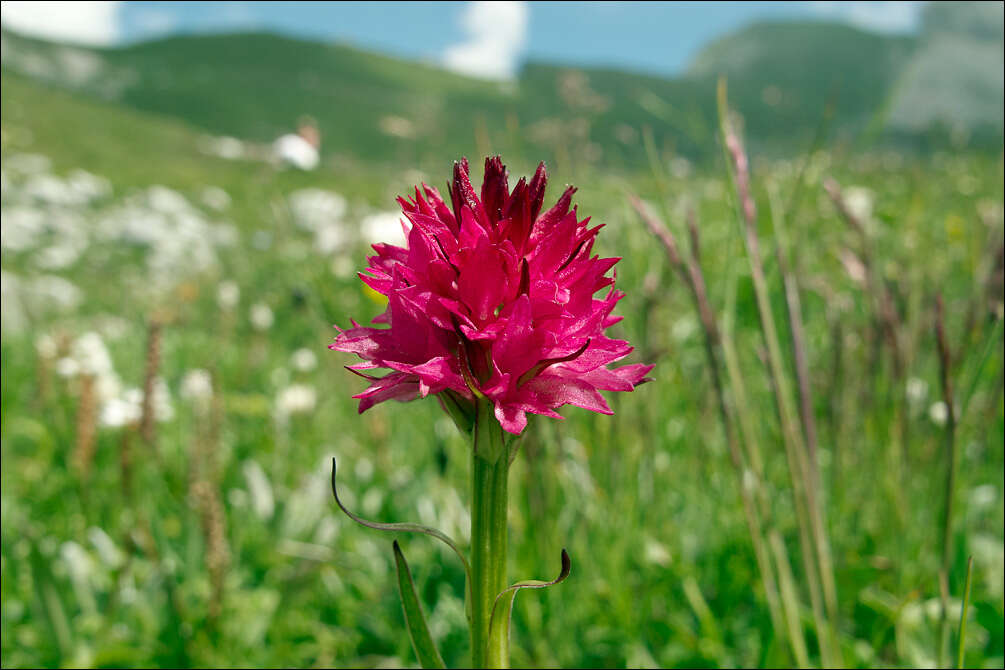
NOTE: Based on a message received from orchid specialist Mr. Wolfram Foelsche my initial determination of the species shown on the pictures of this observation (namely Nigritella widderi Teppner & E. Klein) is wrong. Nigritella widderi doesn't grow on Mangart's flats. According to him the pictures show Nigritella bicolor W. Foelsche. Some orchid experts consider the name Nigritella bicolor W. Foelsche synonymous with Nigritella miniata (Crantz) Janch..___________________________________________________Nigritella widderi Teppner & Klein, syn.: Nigritella rubra ssp. widderi (Teppner & Klein) Baumann & Lorenz, Gymnadenia widderi (Teppner & Klein) Teppner & KleinWidder's Nigritella, DE: Widders Mnnertreu, Widders KohlrschenSlo.: Widderjeva murkaDat.: July 1. 2015Lat.: 46.44176 Long.: 13.64343Code: Bot_897/2015_IMG8786Habitat: alpine grassland, open almost flat terrain, calcareous, skeletal ground, full sun, exposed to direct rain, average precipitations ~ 3.000 mm/year, average temperature 0 - 2 deg C, elevation 1.980 m (6.500 feet), alpine phytogeographical region. Substratum: soil.Place: Mt. Mangart region, Mangart's flats, west of the beginning of the terminal loop of Mt. Mangart tool road, East Julian Alps, Posoje, Slovenia EC Comment: Nigritella widderi was first described as a new taxon thirty years ago in 1985 in calcareous Northeast Alps in Austria. In Slovenia it was first found in Julian Alps south of Mt. Triglav, 2.863 m in 2011 (Ref.: ) . Up to now a few other stands have been found. To distinguish it from other red blooming Nigritella species is not always simple. The important typical traits are purple pink flowers at the bottom of the inflorescence, which are paler than the red ones on the top. The inflorescence looks like having two colors. Also dark purple red bracts, which can be seen among the flowers, are significant. The inflorescence is rather short and never distinctly cylindrical. There are also tiny morphological differences in rostellum, but it is almost impossible to observe them in the field and without a good hand lens or a microscope. In addition, one has to pick the flowers to make observations, which is prohibited, because the species is protected.In 2007 and 2012 I found several of these nice plants at the same place of Mangart's flats as in this case. At that time I determined them as Nigritella rubra. Namely, the taxonomy of genus Nigritella in Slovenia was very simple some time ago. We knew only three species: Nigritella rubra (plants with red flowers), Nigritella nigra (plants with dark red to almost black flowers) and endemic Nigritella rhellicani (with more or less pink flowers), which grows only in Kamnik Alps. Later Dr. W. Foelsche (Ref.:7) recognized my find on Mangart's flats published on the net as an example of a newly defined (in 2010) species Nigritella bicolor. However, the taxon has not been fully recognized and today most authors consider Nigritella bicolor Foelsche as a synonym of Nigritella miniata (Crantz) Janch. (Ref.: 3, Ref.: 8). Anyway, the latest Slovenian literature (Ref.3) lists six species and subspecies of genus Nigritella for my country. Five are of some shade of red. Distinguishing between them with certainty is difficult and, frankly, a too hard a nut for me.Only a single plant in bloom has been found at this place in 2015.Protected according to: Uredba o zavarovanih prostoiveih rastlinskih vrstah, poglavje A, Uradni list RS, t. 46/2004 (Regulation of protected wild plants, chapter A, Official Gazette of Republic Slovenia, no. 46/2004), (2004).Ref.:(1) H.Baumann, S. Kuenkele, R.Lorenz, Orchideen Europas, Ulmer (2006), p 138.(2) H.Kretzschmar, Die Orchideen Deutschlands und angrenzenden Lander, Quelle Meyer (2008), p 188.(3) B.Dolinar, Kukavievke v Sloveniji (Orchidaceae of Slovenia) (in Slovenian), Pipinova Knjiga (2015), p 125.(4) D. Aeschimann, K. Lauber, D.M. Moser, J.P. Theurillat, Flora Alpina, Vol. 2., Haupt (2004), p 1116.(5) M.A. Fischer, W. Adler, K. Oswald, Exkursionsflora fr sterreich, Liechtenstein und Sdtirol, LO Landesmuseen, Linz, Austria (2005), p 1044.(6) I. Dakskobler, B. Dolinar, B. Zupan, R. Iskra, P. Strgar, A. Trnkoczy, Nigritella widderi Tepner and E.Klein, a new species in the flora of Slovenia, Folia biologica et geologica, Academia Scientiarum et Artum Slovenica, 53/1-2 (2012), p 25. (7) W. Foelsche, Nigritella bicolor, ein neues apomiktisches Kohlrschen der Alpen, des Dinarischen Gebirges und der Karpaten. Journal Europischer Orchideen (2010), 42 (1), pp 31 82.(8) G. Perazza, R. Lorenz, Le orchidee dell'Italia nordorientale, atlante corologico e guida al riconoscimento, CIV pubblicazione del Museo Civico di Rovereto, Edizioni Osiride, Rovereto (2013).
-
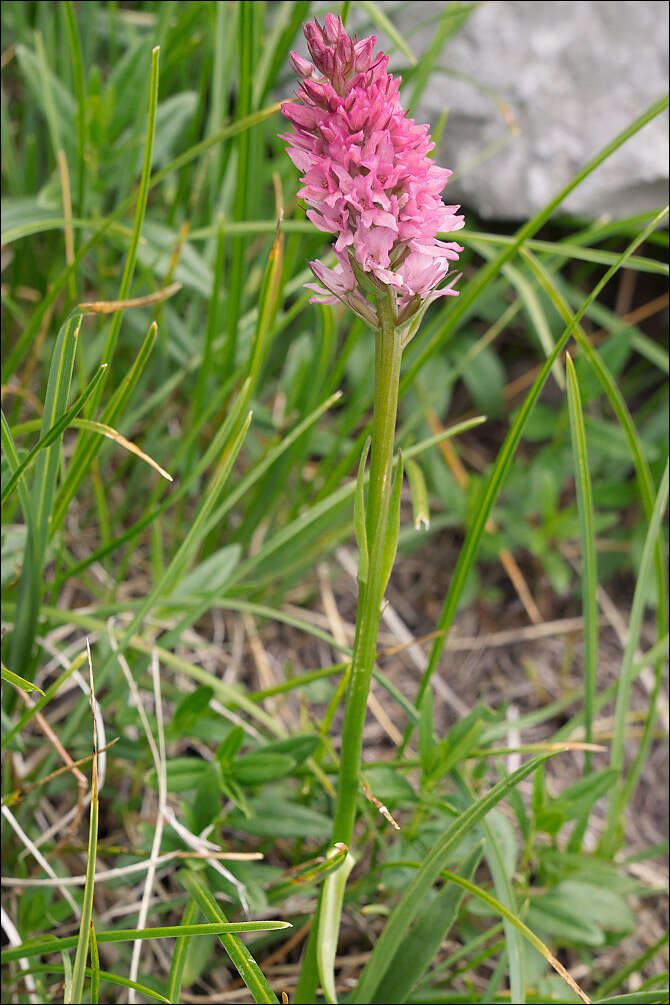
xGymnigritella suaveolens Wettstein, syn.: Gymnadenia conopsea (L.) Brown x Nigritella rhellicani Teppner et KleinFamily: OrchidaceaeEN: no name found, Hybrid between Fragrant and Vanillia Orchid, DE: Hybride zwischen Mcken-Hndelwurz und Schwarzem KohlrschenSlo.: krianec med navadnim kukovinikom in Rhelicanijevo murkoDat.: July 11. 2019Lat.: 46.32864 Long.: 13.47670 (WGS84)Code: Bot_1226/2019_DSC08524Habitat: Alpine grassland, moderately inclined mountain slope, south aspect; calcareous, skeletal ground; relatively warm, dry, sunny, open place; elevation 1.600 m (5.250 feet); average precipitations ~ 3.000 mm/year, average temperature 2-3 deg C, alpine phytogeographical region. Substratum: soil.Place: Mt. Kanin mountain group; next to the trail from Planina Gozdec to Planina Baban, north of Boka waterfall, East Julian Alps, Posoje, Slovenia EC.Comment: (relates to the album xGymnigritella suaveolens): xGymnigritella suaveolens is an intergeneric hybrid resulting from pollination between two plants of different genera - in this case Gymnadenia and Nigritella. In this particular case, this statement is somewhat ambiguous because many botanists consider (or have considered) both genera a single one. They merged the genus Nigritella into the genus Gymnadenia. However, a consensus about this has not been reached yet. Intergeneric hybrids are less common than interspecies hybrids (two different species from the same genus mate). In spite of this xGymnigritella suaveolens are relatively quite common plants. They have easy to spot conspicuous habitus and flowers have saturated color. The plants clearly show intermediate traits of both parents. One of them, easy to observe, is the resupination of the flowers (twisting of the flower stalks through about 180 so they are actually 'upside-down' positioned when they open; therefore, the lip of the most Orchidaceae is pointing downwards), Gymnadenia conopsea has resupinate flowers while those of Nigritella rhellicani are not. Consequently, the hybrid has flowers only partly resupinate to various degree. This can be clearly seen from my pictures. The inflorescence looks in some way chaotic, flowers in the inflorescence are not oriented orderly as with the parents of the hybrid. Protected according to: Uredba o zavarovanih prostoiveih rastlinskih vrstah, poglavje A, Uradni list RS, t. 46/2004 (Regulation of protected wild plants, chapter A, Official Gazette of Republic Slovenia, no. 46/2004), (2004).Ref.(1) Personal communication (Leg. & Det.) with Mr. Branko Dolinar,
www.orhideje.si(2)
docplayer.org/79014904-Die-gattung-nigritella-rich.html (accessed Oct.14. 2020)(3)
grabner-orchideen.com/is_hybrids/hyb_gy_co_gy_rh.htm (accessed Oct.14. 2020)(4) Kretzschmar, Die Orchideen Deutschlands und angrenzenden Lander, Quelle Meyer (2008), p 272.(5) N. Griebl, Intergenerische Hybriden in den Alpen, Ber. Arbeitskrs. Heim. Orchid. (2008), 25 (1): 254 - 280
-
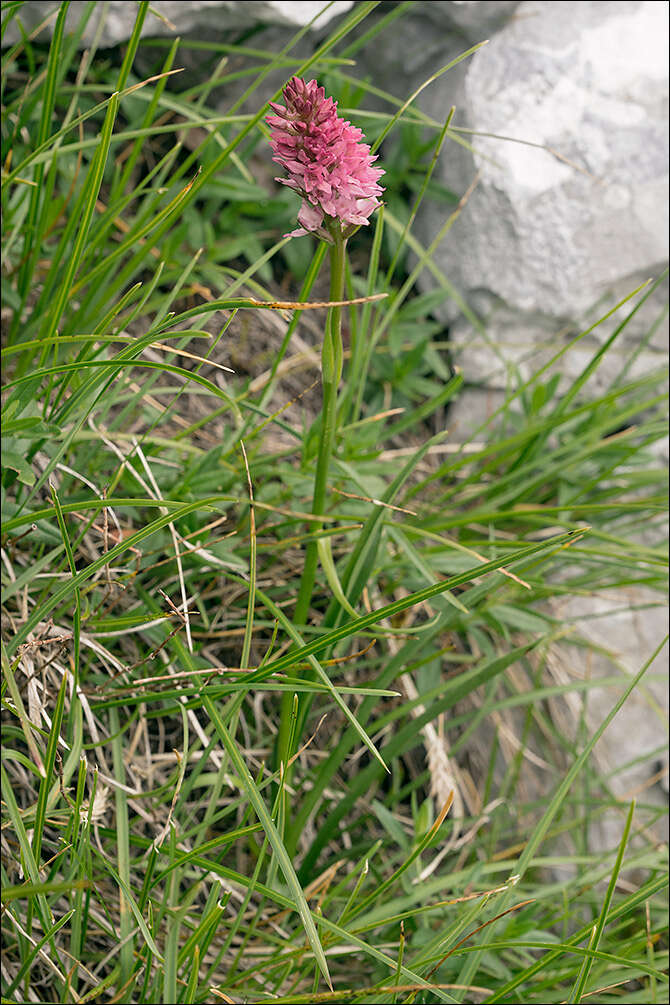
xGymnigritella suaveolens Wettstein, syn.: Gymnadenia conopsea (L.) Brown x Nigritella rhellicani Teppner et KleinFamily: OrchidaceaeEN: no name found, Hybrid between Fragrant and Vanillia Orchid, DE: Hybride zwischen Mcken-Hndelwurz und Schwarzem KohlrschenSlo.: krianec med navadnim kukovinikom in Rhelicanijevo murkoDat.: July 11. 2019Lat.: 46.32864 Long.: 13.47670 (WGS84)Code: Bot_1226/2019_DSC08524Habitat: Alpine grassland, moderately inclined mountain slope, south aspect; calcareous, skeletal ground; relatively warm, dry, sunny, open place; elevation 1.600 m (5.250 feet); average precipitations ~ 3.000 mm/year, average temperature 2-3 deg C, alpine phytogeographical region. Substratum: soil.Place: Mt. Kanin mountain group; next to the trail from Planina Gozdec to Planina Baban, north of Boka waterfall, East Julian Alps, Posoje, Slovenia EC.Comment: (relates to the album xGymnigritella suaveolens): xGymnigritella suaveolens is an intergeneric hybrid resulting from pollination between two plants of different genera - in this case Gymnadenia and Nigritella. In this particular case, this statement is somewhat ambiguous because many botanists consider (or have considered) both genera a single one. They merged the genus Nigritella into the genus Gymnadenia. However, a consensus about this has not been reached yet. Intergeneric hybrids are less common than interspecies hybrids (two different species from the same genus mate). In spite of this xGymnigritella suaveolens are relatively quite common plants. They have easy to spot conspicuous habitus and flowers have saturated color. The plants clearly show intermediate traits of both parents. One of them, easy to observe, is the resupination of the flowers (twisting of the flower stalks through about 180 so they are actually 'upside-down' positioned when they open; therefore, the lip of the most Orchidaceae is pointing downwards), Gymnadenia conopsea has resupinate flowers while those of Nigritella rhellicani are not. Consequently, the hybrid has flowers only partly resupinate to various degree. This can be clearly seen from my pictures. The inflorescence looks in some way chaotic, flowers in the inflorescence are not oriented orderly as with the parents of the hybrid. Protected according to: Uredba o zavarovanih prostoiveih rastlinskih vrstah, poglavje A, Uradni list RS, t. 46/2004 (Regulation of protected wild plants, chapter A, Official Gazette of Republic Slovenia, no. 46/2004), (2004).Ref.(1) Personal communication (Leg. & Det.) with Mr. Branko Dolinar,
www.orhideje.si(2)
docplayer.org/79014904-Die-gattung-nigritella-rich.html (accessed Oct.14. 2020)(3)
grabner-orchideen.com/is_hybrids/hyb_gy_co_gy_rh.htm (accessed Oct.14. 2020)(4) Kretzschmar, Die Orchideen Deutschlands und angrenzenden Lander, Quelle Meyer (2008), p 272.(5) N. Griebl, Intergenerische Hybriden in den Alpen, Ber. Arbeitskrs. Heim. Orchid. (2008), 25 (1): 254 - 280
-

xGymnigritella suaveolens Wettstein, syn.: Gymnadenia conopsea (L.) Brown x Nigritella rhellicani Teppner et KleinFamily: OrchidaceaeEN: no name found, Hybrid between Fragrant and Vanillia Orchid, DE: Hybride zwischen Mcken-Hndelwurz und Schwarzem KohlrschenSlo.: krianec med navadnim kukovinikom in Rhelicanijevo murkoDat.: July 11. 2019Lat.: 46.32864 Long.: 13.47670 (WGS84)Code: Bot_1226/2019_DSC08524Habitat: Alpine grassland, moderately inclined mountain slope, south aspect; calcareous, skeletal ground; relatively warm, dry, sunny, open place; elevation 1.600 m (5.250 feet); average precipitations ~ 3.000 mm/year, average temperature 2-3 deg C, alpine phytogeographical region. Substratum: soil.Place: Mt. Kanin mountain group; next to the trail from Planina Gozdec to Planina Baban, north of Boka waterfall, East Julian Alps, Posoje, Slovenia EC.Comment: (relates to the album xGymnigritella suaveolens): xGymnigritella suaveolens is an intergeneric hybrid resulting from pollination between two plants of different genera - in this case Gymnadenia and Nigritella. In this particular case, this statement is somewhat ambiguous because many botanists consider (or have considered) both genera a single one. They merged the genus Nigritella into the genus Gymnadenia. However, a consensus about this has not been reached yet. Intergeneric hybrids are less common than interspecies hybrids (two different species from the same genus mate). In spite of this xGymnigritella suaveolens are relatively quite common plants. They have easy to spot conspicuous habitus and flowers have saturated color. The plants clearly show intermediate traits of both parents. One of them, easy to observe, is the resupination of the flowers (twisting of the flower stalks through about 180 so they are actually 'upside-down' positioned when they open; therefore, the lip of the most Orchidaceae is pointing downwards), Gymnadenia conopsea has resupinate flowers while those of Nigritella rhellicani are not. Consequently, the hybrid has flowers only partly resupinate to various degree. This can be clearly seen from my pictures. The inflorescence looks in some way chaotic, flowers in the inflorescence are not oriented orderly as with the parents of the hybrid. Protected according to: Uredba o zavarovanih prostoiveih rastlinskih vrstah, poglavje A, Uradni list RS, t. 46/2004 (Regulation of protected wild plants, chapter A, Official Gazette of Republic Slovenia, no. 46/2004), (2004).Ref.(1) Personal communication (Leg. & Det.) with Mr. Branko Dolinar,
www.orhideje.si(2)
docplayer.org/79014904-Die-gattung-nigritella-rich.html (accessed Oct.14. 2020)(3)
grabner-orchideen.com/is_hybrids/hyb_gy_co_gy_rh.htm (accessed Oct.14. 2020)(4) Kretzschmar, Die Orchideen Deutschlands und angrenzenden Lander, Quelle Meyer (2008), p 272.(5) N. Griebl, Intergenerische Hybriden in den Alpen, Ber. Arbeitskrs. Heim. Orchid. (2008), 25 (1): 254 - 280
-
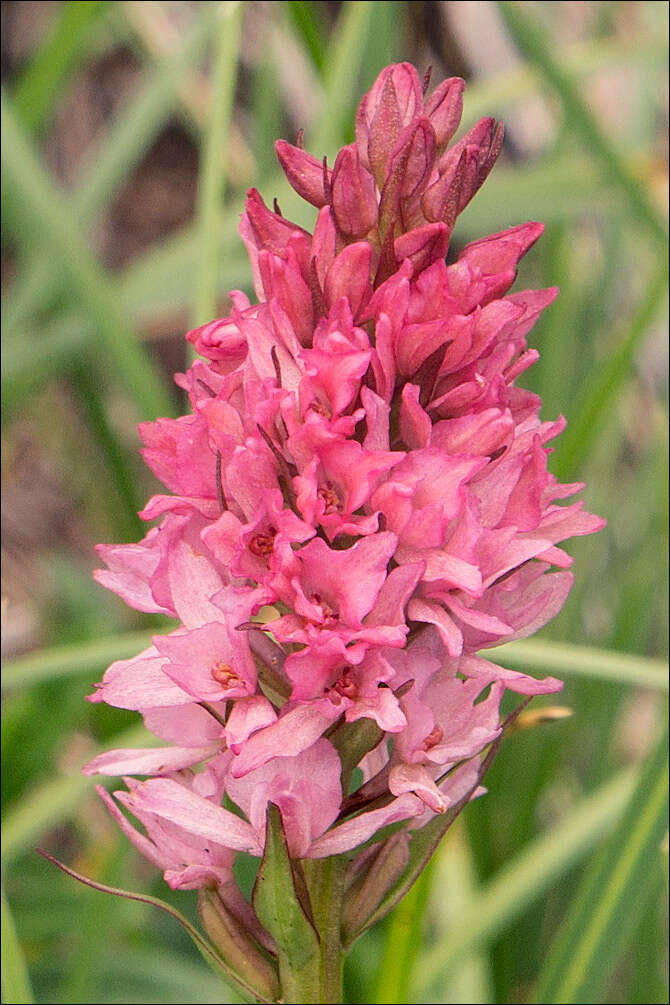
xGymnigritella suaveolens Wettstein, syn.: Gymnadenia conopsea (L.) Brown x Nigritella rhellicani Teppner et KleinFamily: OrchidaceaeEN: no name found, Hybrid between Fragrant and Vanillia Orchid, DE: Hybride zwischen Mcken-Hndelwurz und Schwarzem KohlrschenSlo.: krianec med navadnim kukovinikom in Rhelicanijevo murkoDat.: July 11. 2019Lat.: 46.32864 Long.: 13.47670 (WGS84)Code: Bot_1226/2019_DSC08524Habitat: Alpine grassland, moderately inclined mountain slope, south aspect; calcareous, skeletal ground; relatively warm, dry, sunny, open place; elevation 1.600 m (5.250 feet); average precipitations ~ 3.000 mm/year, average temperature 2-3 deg C, alpine phytogeographical region. Substratum: soil.Place: Mt. Kanin mountain group; next to the trail from Planina Gozdec to Planina Baban, north of Boka waterfall, East Julian Alps, Posoje, Slovenia EC.Comment: (relates to the album xGymnigritella suaveolens): xGymnigritella suaveolens is an intergeneric hybrid resulting from pollination between two plants of different genera - in this case Gymnadenia and Nigritella. In this particular case, this statement is somewhat ambiguous because many botanists consider (or have considered) both genera a single one. They merged the genus Nigritella into the genus Gymnadenia. However, a consensus about this has not been reached yet. Intergeneric hybrids are less common than interspecies hybrids (two different species from the same genus mate). In spite of this xGymnigritella suaveolens are relatively quite common plants. They have easy to spot conspicuous habitus and flowers have saturated color. The plants clearly show intermediate traits of both parents. One of them, easy to observe, is the resupination of the flowers (twisting of the flower stalks through about 180 so they are actually 'upside-down' positioned when they open; therefore, the lip of the most Orchidaceae is pointing downwards), Gymnadenia conopsea has resupinate flowers while those of Nigritella rhellicani are not. Consequently, the hybrid has flowers only partly resupinate to various degree. This can be clearly seen from my pictures. The inflorescence looks in some way chaotic, flowers in the inflorescence are not oriented orderly as with the parents of the hybrid. Protected according to: Uredba o zavarovanih prostoiveih rastlinskih vrstah, poglavje A, Uradni list RS, t. 46/2004 (Regulation of protected wild plants, chapter A, Official Gazette of Republic Slovenia, no. 46/2004), (2004).Ref.(1) Personal communication (Leg. & Det.) with Mr. Branko Dolinar,
www.orhideje.si(2)
docplayer.org/79014904-Die-gattung-nigritella-rich.html (accessed Oct.14. 2020)(3)
grabner-orchideen.com/is_hybrids/hyb_gy_co_gy_rh.htm (accessed Oct.14. 2020)(4) Kretzschmar, Die Orchideen Deutschlands und angrenzenden Lander, Quelle Meyer (2008), p 272.(5) N. Griebl, Intergenerische Hybriden in den Alpen, Ber. Arbeitskrs. Heim. Orchid. (2008), 25 (1): 254 - 280
-
Gymnadenia conopsea occurring in the subalpine region of southern Bavaria.
-
Gymnadenia conopsea occurring in the subalpine region of southern Bavaria.
-
Gymnadenia conopsea occurring in the subalpine region of southern Bavaria.
-
Gymnadenia conopsea occurring in the subalpine region of southern Bavaria.

